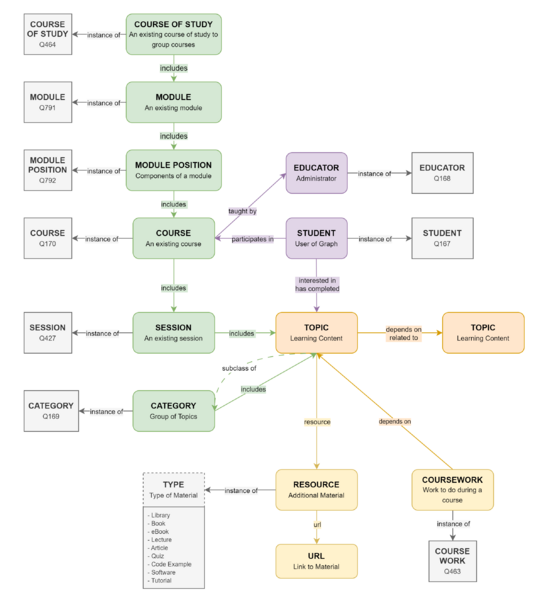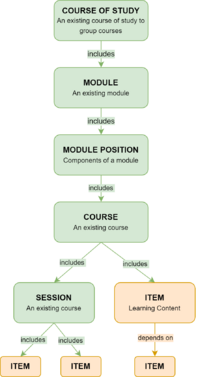GraphStructure
A Documentation of the structure behind the Graph.
Graph Structure
Topic
A topic describes a learning content (as most items in the graph are topics, their type/class is not explicitly defined). It uses the property subclass of to link to a defined Category, that is used to group topics. A depends on link from one topic to another indicates that the other topic is necessary prerequisite knowledge. A related to link indicates a similar topic. Additionally for each topic, resources can be associated with a resource.
A short overview of possible links:
| Topic | — subclass of → | Category |
| Topic | — depends on → | Prerequisite (another item) |
| Topic | — related to → | Equivalent (another item) |
| Topic | — resource → | Resource |
| Topic | — instance of → | Application |
Additionally an item can be defined further by linking an importance-item using importance. This can be done as simple link or as an added value to a property. See Section: Importance
Resources
A Resource is an item that contains a link to some resource (property: url) hosted on the Wiki or on another platform. It usually is an instance of a Resource Class, as seen below.
All classes that a resource can be an instance of
A short overview:
| Resource | — url → | URL |
| Resource | — instance of → | Resource Class |
See: Item:Q280 as an example and Resource to reference a dummy element
Category
A general category, such as "Mathematical Foundations"; used to group topics.
They can be used as templates or building kits, to give an overview of existing items, that can be included in a course/session.
A short overview:
| Category-Item | — instance of → | Category |
| Category-Item | — includes → | Learning Content |
Course of Study
This item describes the course of a study path and bundles the set of courses that are included in that path. This is used for example to display the path through a major that a student is enrolled in and what lectures or courses are part of the program.
A specific Course of Study is declared by making it an instance of the Course of Study-Item and then linking a course to it using the includes-property.
| Course of Study-Item | — instance of → | Course of Study |
| Course of Study-Item | — includes → | Course-Item |
TODO: example
Course
A course encompasses a collection of learning contents. It is the equivalent of a course officially taught by the university that a student enrolls in. To declare an item as a Course use the instance of property.
Futhermore a course can include several other items, such as a Session-Item, or any learning content directly. This structure can later be used to help classify which course an item can belong to.
The diagram on the left gives a simple illustration of how this graph structure works.
| Before February 2025 a course could also include a Category-Item. This was deprecated to better differentiate between courses if they used the same category.
This avoids including any items in a course that are part of a category, but not part of the curriculum. |
A short overview:
| Course | — instance of → | Course |
| Course | — taught by → | Educator |
| Course | — includes → | Session item |
| Course | — includes → | Learning Content |
See: Item:Q171 as an example.
A course can include multiple Sessions.
These may be used to structure the course contents, to follow the structure and pacing of the real course.
A timeline of all items included in the MMT WS24/25 course
Session
A Session allows grouping multiple items that are discussed within an actual course session.
The Sessions and their topics for the CGBV-course
See: Item:Q248 as an example.
A short overview:
| Session-Item | — instance of → | Session |
| Session-Item | — includes → | Item |
| Course-Item | — on date → | Date |
Coursework or Exercise
Defines work that is to be done for a course, such as mandatory exercises or exams. An item is marked as coursework by making it an instance of Coursework.
It can be used to create a Template:Learning Path using syntax like:
{{Learning Path|quiz=wd:Q451}}.
A short overview:
| Course Work-Item | — url → | URL |
| Course Work-Item | — instance of → | Course Work |
| Course Work-Item | — importance → | Importance-Item |
| Course Work-Item | — includes → | Item |
| Course Work-Item | — language → | Language-Item |
See: Item:Q451 as an example.
Idea October 2025
A Coursework or Exercise-Item is attached to a specific course using the resource-Property.
A Student can mark an Exercise-Item as completed. This should automatically create a statement connecting the student to the completed items included in the exercise. It has an additional qualifier to state that the connection was created by completing the exercise, i.e. the connection was certified by the exercise.
This should not override existing connection, with no or different qualifiers, so that one can tell the difference between a completion manually created by a student, and those automatically created by completing an Exercise-Item.
| Student | — has completed → | Item |
| (qualifier) | — certified by → | Item |
✒️ Due to data privacy converns, this is currently not being implemented (as all data is currently public)
People
Student
The role of a student is declared by linking from an item to Student using instance of. The student then can link their item to others using interested in and has completed to organize their interests and progress.
A short overview:
| Student-Item | — instance of → | Student |
| Student-Item | — interested in → | Item |
| Student-Item | — has completed → | Item |
| Student-Item | — participates in → | Course, Session |
See: Item:Q157 as an example.
Educator
The role of an educator is declared by linking from an item to Educator using instance of.
See: Item:Q158 as an example.
Importance
An items that describes an importance to learn a learning content. It's linked to using importance.
| Item | — importance → | Mandatory |
| Item | — importance → | Essential |
| Item | — importance → | Recommended |
| Item | — importance → | Optional |
Properties
Important Properties:
| Property | Name | Used for | Links to → |
|---|---|---|---|
| Property:P1 | depends on | Prerequisites | Learning contents |
| Property:P2 | subclass of | Grouping items into Topics | Categories |
| Property:P3 | instance of | Abstract Classes | Category |
| Property:P4 | related to | Equivalents | Learning contents |
| Property:P14 | includes | Making a list of items | Learning Contents, Sessions |
| Property:P37 | properties for this type | List of properties that apply | Property |
| Property:P21 | resource | Link to a resource | Resources |
| Property:P20 | url | save a URL | URL |
| Property:P11 | image | declare images for items | Image (from Wikimedia Commons) |
| Property:P12 | has completed | Completion | Learning Contents, (Sessions, Courses) |
| Property:P23 | interested in | Declare interests | Learning contents |
| Property:P25 | participates in | Participation | Courses, Sessions |
| Property:P13 | importance | Declaring importance | Learning contents |
| Property:P16 | created by | Author | Person |
| Property:P17 | modified by | Author | Person |
| Property:P22 | certified by | Author | Educator |
| Property:P24 | taught by | Author | Educator |
| Property:P19 | on date | Timeliness | Date |
| Property:P15 | comment | Note something | String |
| Property:P26 | language | Declare the language | Items |
Items using property for this type and what properties they link to:


